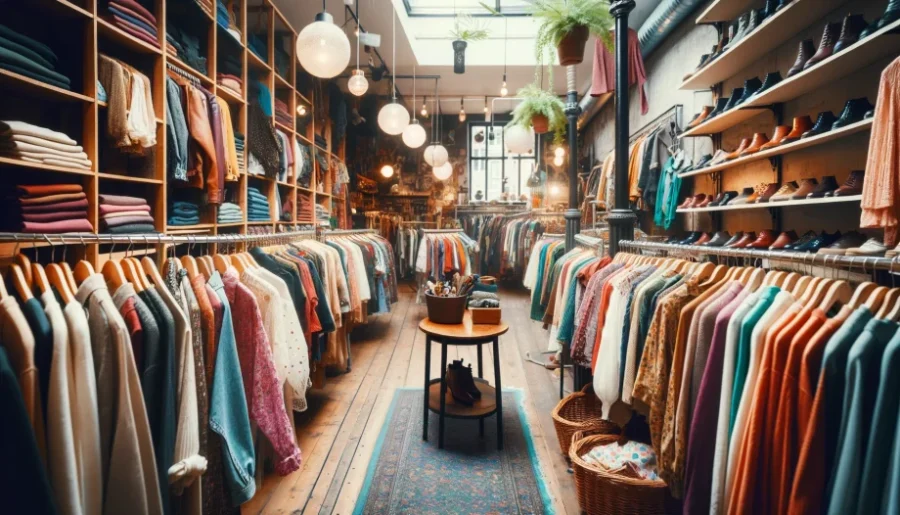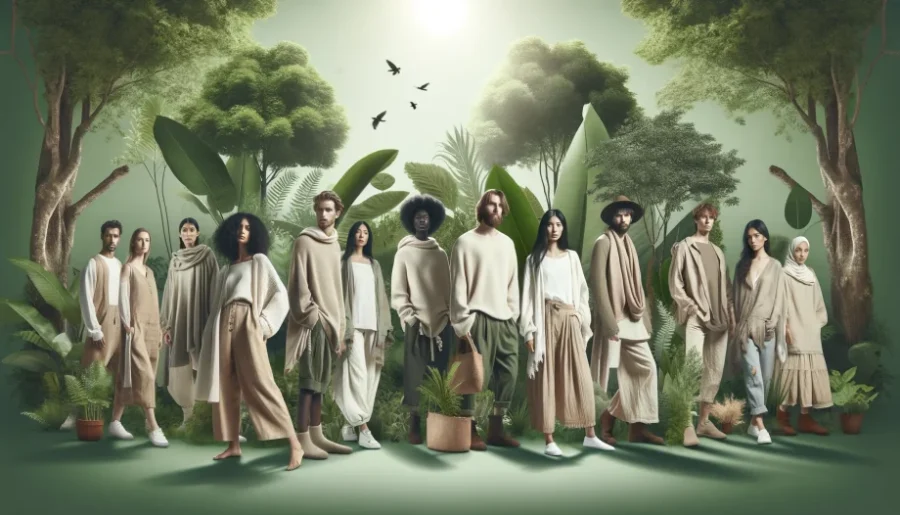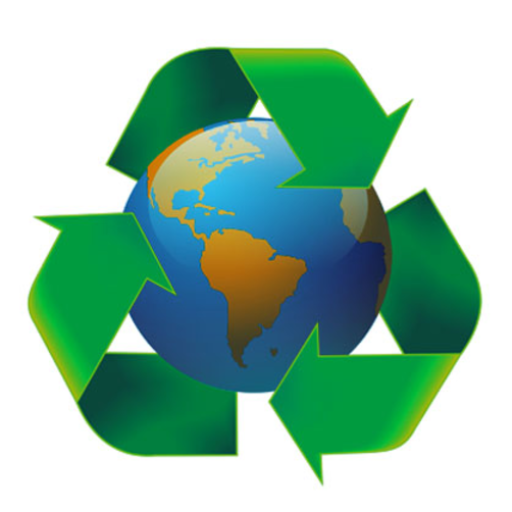
Hey there, eco-conscious fashionistas! Are you looking to spruce up your wardrobe without splurging or harming the planet? You’re in luck!
We’re diving into the world of sustainable fashion on a budget, showing you how to stay stylish and environmentally friendly without spending a fortune.
Get ready to embrace a sustainable style that’s kind to both your wallet and the Earth!
Sustainable Fashion Key Takeaways:
- Sustainable fashion on a budget involves choosing eco-friendly and ethically made clothing without overspending.
- It includes shopping secondhand, investing in quality pieces, supporting affordable sustainable brands, and embracing DIY and upcycling.
- You can enjoy a stylish wardrobe that aligns with your values and budget by making mindful choices.
Sustainable Fashion on a Budget: How to Stay Stylish and Eco-Friendly
Looking good doesn’t have to cost the Earth – literally. With sustainable fashion on the rise, you can rock the latest styles without breaking the bank or harming the planet.
In this guide, we’ll show you how to stay chic and eco-friendly, all while keeping your wallet happy.
From thrifting like a pro to discovering hidden gems among sustainable brands, we’ve got all the tips to make sustainable fashion a part of your everyday life.
Sustainable Fashion Brands vs. Fast Fashion Brands- Swapping Disposable Items for Reusable Alternatives
| Feature | Sustainable Fashion Brands | Fast Fashion Brands |
|---|---|---|
| Environmental Impact | Low; uses eco-friendly materials and practices | High; contributes to pollution and waste |
| Cost Over Time | Lower; durable and timeless pieces last longer | Higher; frequent replacements needed |
| Ethical Production | Yes; fair wages and safe working conditions | Often no; exploitation and poor working conditions |
| Style and Versatility | Timeless; encourages versatile styling | Trend-driven; quickly goes out of fashion |
1. Understanding Sustainable Fashion Brands
When we talk about sustainable fashion brands, we’re looking at companies that give a hoot about the planet.
They’re all about creating clothes that not only look good but also do good.
They pay their workers fair wages, use eco-friendly materials, and try to keep their carbon footprint as tiny as possible.
In this section, we’ll dive into what makes a brand truly sustainable and why it’s worth your attention.
Sustainable Brands Overview
| Brand Name | Sustainability Practices | Price Range | Product Highlights |
|---|---|---|---|
| Brand A | Uses organic cotton, fair labor practices | $20-$100 | Eco-friendly t-shirts and jeans |
| Brand B | Recycled materials, carbon-neutral shipping | $30-$150 | Sustainable outerwear and accessories |
What Makes a Brand Sustainable?
Sustainable fashion brands are all about creating clothes that are good for both people and the planet.
They focus on using eco-friendly materials, like organic cotton or recycled fabrics, which have a smaller environmental footprint.
These brands also make sure their workers are treated fairly, with safe working conditions and fair wages.
Plus, they often use production methods that reduce waste and pollution.
So, when you buy from a sustainable brand, you’re not just getting a cool outfit – you’re also helping to make the world a better place!
The Importance of Fair Wages in Fashion
In the fashion world, paying workers fair wages is super important. It means that the people who make our clothes can afford to live a decent life.
Many fashion brands outsource their production to countries where labor is cheap, but this often leads to workers being underpaid and overworked.
Sustainable brands, on the other hand, make sure their workers are paid properly for their time and effort.
This not only helps the workers and their families, but it also supports the local economy and encourages ethical business practices.
How Sustainable Brands Reduce Environmental Impact
Sustainable brands are on a mission to reduce the fashion industry’s impact on the environment.
They use materials that are kinder to the planet, like organic cotton, which uses less water and no harmful pesticides.
They also focus on reducing waste by designing clothes that are made to last or by recycling materials to create new products.
Plus, many sustainable brands use renewable energy sources and try to cut down on carbon emissions during production and shipping.
By choosing sustainable fashion, you’re helping to protect our planet for future generations!
2. The Problem with Fast Fashion Brands
Fast fashion might seem like a steal with its low prices and trendy styles, but it’s got a dark side.
These brands often prioritize profits over people and the planet, leading to some not-so-great consequences.
Let’s peel back the layers and see why fast fashion might not be the bargain it appears to be.
Environmental and Social Impact of Fast Fashion
| Issue | Description |
|---|---|
| Water Pollution | Use of toxic dyes and chemicals polluting water bodies |
| Low Wages | Workers are paid below the living wage, impacting livelihoods |
| Overproduction | Leads to waste and environmental damage |
| Poor Working Conditions | Often unsafe, with overworked employees |
The Environmental Cost of Fast Fashion
Fast fashion comes with a hefty price tag for the environment. Here are some of the ways it impacts our planet:
- Water Pollution: The production of cheap clothing often involves toxic dyes and chemicals that end up polluting rivers and oceans.
- High Water Consumption: It takes a lot of water to grow cotton and produce garments, putting strain on already scarce water resources.
- Greenhouse Gas Emissions: The fashion industry is a major contributor to carbon emissions, mainly due to the energy-intensive production processes and long transportation routes.
- Waste: Fast fashion encourages a throwaway culture, leading to massive amounts of textile waste ending up in landfills each year.
Social Issues in the Fast Fashion Industry
The fast fashion industry also faces several social challenges:
- Poor Working Conditions: Many workers in the fast fashion industry work in unsafe environments, with little regard for their health and safety.
- Low Wages: Workers are often paid below the living wage, making it difficult for them to meet their basic needs.
- Child Labor: In some cases, fast fashion brands have been linked to the use of child labor in their supply chains.
- Exploitation: Workers may face exploitation in the form of forced overtime, discrimination, and limited freedom of association.
Why Fast Fashion is Unsustainable
Fast fashion is unsustainable for several reasons:
- Overproduction: Fast fashion brands produce more clothes than needed, leading to waste and environmental damage.
- Short Lifespan of Products: The focus on trends means that clothes are often discarded after just a few wears, contributing to a culture of waste.
- Resource Intensive: The production of cheap garments requires large amounts of water, energy, and chemicals, depleting natural resources.
- Lack of Transparency: Many fast fashion brands lack transparency in their supply chains, making it difficult to hold them accountable for environmental and social issues.
By understanding the true cost of fast fashion, consumers can make more informed choices and support brands that prioritize sustainability and ethical practices.
3. Exploring Thrift Stores and Second-Hand Options
Thrift stores are like treasure chests for sustainable fashionistas. They’re packed with unique finds that won’t drain your wallet or the planet’s resources.
In this section, we’ll share some tips on how to score the best deals and find those one-of-a-kind pieces that make your wardrobe stand out.
Benefits of Shopping Second-Hand
Shopping second-hand is not only kind to your wallet, but it’s also great for the planet. Here’s why:
- Reduces Waste: By giving pre-loved items a new home, you’re helping to reduce the amount of clothing that ends up in landfills.
- Saves Resources: Second-hand shopping means fewer new items need to be produced, which conserves water, energy, and raw materials.
- Unique Finds: Thrift stores and second-hand shops are treasure troves of unique, vintage, and one-of-a-kind pieces.
- Supports Local Communities: Many thrift stores are run by charities, so your purchases can help support important social causes.
Exploring Thrift Stores and Second-Hand Options
Benefits of Shopping Second-Hand
| Benefit | Description |
|---|---|
| Reduces Waste | Extends the life cycle of clothing, reducing landfill waste |
| Saves Resources | Decreases the need for new productions, saving raw materials |
| Unique Finds | Offers unique, often vintage items not available in regular stores |
| Supports Local Communities | Often supports local charities and social causes |
How to Find Quality Items in Thrift Stores
To score high-quality finds in thrift stores, keep these tips in mind:
- Inspect Carefully: Check for any signs of wear and tear, such as stains, holes, or missing buttons.
- Know Your Fabrics: Look for durable materials like wool, cotton, and linen that tend to last longer.
- Try It On: Sizes can vary widely, especially with vintage items, so always try things on to ensure a good fit.
- Visit Often: Thrift store inventory changes frequently, so regular visits can increase your chances of finding great items.
- Be Patient: Thrifting requires some digging, so take your time and enjoy the hunt.
The Role of Online Marketplaces in Sustainable Fashion
Online marketplaces have become a game-changer for sustainable fashion:
- Accessibility: Platforms like eBay, Depop, and Poshmark make it easy to shop for second-hand clothing from anywhere.
- Wide Selection: Online marketplaces offer a vast array of options, from vintage designer pieces to everyday wear.
- Peer-to-Peer Selling: These platforms allow individuals to sell directly to each other, fostering a sense of community and reducing the need for middlemen.
- Convenience: Shopping for second-hand items online is convenient, with detailed product descriptions and the ability to search for specific items or brands.
By utilizing online marketplaces, you can expand your sustainable fashion choices and find unique pieces that align with your style and values.
4. Investing in the Long Run: Quality Over Quantity

In the world of sustainable fashion, less is more. Instead of filling your closet with disposable clothes, we’ll show you how investing in fewer, higher-quality pieces can save you money and reduce waste in the long run.
The Advantages of Timeless Pieces
Timeless pieces are the backbone of a sustainable wardrobe. Here’s why they’re a smart choice:
- Versatility: Classic items like a little black dress or a well-fitted blazer can be styled in countless ways, making them suitable for various occasions.
- Longevity: Timeless pieces are often made with higher quality materials and craftsmanship, meaning they’ll last you for years.
- Cost-Effective: Investing in timeless pieces can save you money in the long run, as you won’t need to constantly replace them.
- Reduced Environmental Impact: By wearing your clothes for longer, you’re helping to decrease the demand for fast fashion and reduce waste.
Investing in the Long Run: Quality Over Quantity
Advantages of Timeless Pieces
| Advantage | Description |
|---|---|
| Versatility | Can be styled in multiple ways for various occasions |
| Longevity | Made with quality materials to last longer |
| Cost-Effective | Higher initial cost but lower cost per wear |
| Reduced Environmental Impact | Fewer resources needed over the item’s lifespan |
How to Assess the Quality of Clothing
To ensure you’re investing in high-quality clothing, consider the following:
- Fabric: Look for natural fibers like cotton, linen, wool, and silk, which are generally more durable and breathable than synthetic materials.
- Construction: Check the seams, hems, and stitching. They should be even, tight, and without loose threads.
- Fit: Well-made clothing should fit properly and flatter your body shape. Pay attention to how the garment drapes and moves.
- Brand Reputation: Do some research on the brand. Established brands with a commitment to quality and sustainability are more likely to produce durable clothing.
The Cost-Per-Wear Formula: A Smart Shopping Guide
The Cost-Per-Wear (CPW) formula helps you determine the true value of a clothing item:
- CPW Calculation: Divide the price of the item by the number of times you expect to wear it. For example, a $100 coat worn 50 times has a CPW of $2.
- Assessing Value: A lower CPW indicates better value. It’s often worth investing in more expensive items if they’re high quality and will be worn frequently.
- Long-Term Savings: Using the CPW formula can help you save money by encouraging you to invest in versatile, durable pieces rather than cheap, trendy items.
By considering the advantages of timeless pieces, assessing the quality of clothing, and using the CPW formula, you can build a sustainable wardrobe that’s both stylish and budget-friendly.
5. Fair Trade and Ethical Fashion: A Good Reason to Switch
Fair trade and ethical fashion are all about respecting people and the planet. We’ll explore how these practices make a difference and how you can support them with your fashion choices.
Understanding Fair Trade in Fashion
Fair Trade in fashion is about creating clothing that respects both people and the planet.
It ensures that workers in developing countries receive fair wages, work in safe conditions, and have the right to organize.
The principles of Fair Trade also emphasize environmental sustainability and cultural identity, ensuring that traditional crafts and communities are honored and supported.
Brands like LAUDE the Label, People Tree, and Eileen Fisher are leading the way in Fair Trade fashion.
They prioritize ethical production, use sustainable materials, and commit to transparency in their supply chains.
Fair Trade and Ethical Fashion: A Good Reason to Switch
Key Aspects of Fair Trade and Ethical Fashion
| Aspect | Importance |
|---|---|
| Fair Wages | Ensures a decent living standard for workers |
| Safe Working Conditions | Protects the health and safety of workers |
| Sustainable Materials | Uses materials that are better for the environment |
| Support for Local Communities | Helps sustain local economies and traditions |
Ethical Brands Making a Difference
Ethical brands are making a significant impact by prioritizing fair wages, safe working conditions, and environmental sustainability.
Some examples include Patagonia, Nudie Jeans, and Pact, which are known for their commitment to Fair Trade practices and use of organic cotton.
These brands demonstrate that it’s possible to create fashionable clothing that’s both ethical and sustainable.
How to Spot and Support Ethical Fashion
To support ethical fashion, look for certifications like Fair Trade Certified, Global Organic Textile Standard (GOTS), and Bluesign, which indicate that clothing has been produced ethically and sustainably. Shopping for Fair Trade fashion can be made easier with apps like Good On You, which rank brands based on their ethical practices.
By choosing Fair Trade and ethical fashion, consumers can help drive change in the industry, supporting better working conditions, environmental protection, and sustainable community development.
6. Giving Old Clothes a New Life
Don’t toss out those old clothes just yet! We’ve got some creative ideas to breathe new life into your wardrobe.
From simple DIY tricks to participating in clothing swaps, we’ll show you how to make sustainable fashion fun and accessible.
DIY Tips for Upcycling Old Clothes
Upcycling old clothes is a great way to give them new life and add a personal touch to your wardrobe. Here are some ideas:
- Transform T-Shirts: Turn old t-shirts into tote bags by cutting fringes at the bottom and tying them together.
- Denim Projects: Jeans can be turned into shorts, skirts, or even quilted picnic blankets.
- Sweater Mittens: Use the intact parts of old sweaters to make cozy mittens.
- Patchwork Quilts: Combine fabric from different garments to create a unique patchwork quilt.
Giving Old Clothes a New Life
DIY Tips for Upcycling Old Clothes
| DIY Project | Materials Needed |
|---|---|
| Tote Bag from T-Shirts | Old t-shirt, scissors, optional sewing kit |
| Denim Quilts | Old jeans, thread, sewing machine (optional) |
| Sweater Mittens | Old sweater, sewing kit |
The Benefits of Clothing Swaps
Clothing swaps are a fun and sustainable way to refresh your wardrobe. Here are some benefits:
- Reduce Waste: Swapping clothes helps reduce the amount of textile waste that ends up in landfills.
- Save Money: You can get new-to-you clothes without spending any money.
- Community Building: Clothing swaps are a great way to meet new people and build a sense of community.
How to Organize a Successful Swap Event
Organizing a clothing swap event requires some planning. Here are a few tips:
- Choose a Venue: Find a suitable space that can accommodate the number of participants and clothing items.
- Set the Rules: Decide on the guidelines for the swap, such as the condition of the clothes and how many items each person can take.
- Promote the Event: Use social media, flyers, and word of mouth to spread the word and attract participants.
- Organize the Clothes: Set up tables or racks to display the clothes neatly, sorted by type or size.
- Facilitate the Swap: Ensure that the event runs smoothly by helping participants find what they’re looking for and keeping track of the items swapped.
By following these tips, you can host a successful clothing swap event that promotes sustainability and community engagement.
7. Sustainable Fabrics and Materials: The Future of Fashion
Not all fabrics are created equal. In this section, we’ll dive into the world of sustainable materials, exploring how they’re made and why they’re better for the environment.
Eco-Friendly Materials You Should Know About
When it comes to sustainable fashion, choosing eco-friendly materials is crucial. Here are some materials to consider:
- Organic Cotton: Grown without harmful pesticides, organic cotton has a lower environmental impact than conventional cotton.
- Linen: Made from flax plants, linen is biodegradable and requires less water than cotton to grow.
- Hemp: Hemp is a durable and fast-growing crop that requires minimal chemicals and water to cultivate.
- Tencel (Lyocell): Made from wood pulp, Tencel is biodegradable and produced in a closed-loop process that recycles water and solvents.
- Recycled Polyester: Made from recycled plastic bottles, recycled polyester reduces plastic waste and energy consumption compared to virgin polyester.
- Bamboo: Bamboo is a fast-growing plant that requires no pesticides and little water, but be cautious of the processing method used to turn bamboo into fabric, as it can be environmentally harmful.
Sustainable Fabrics and Materials: The Future of Fashion – Eco-Friendly Materials Comparison
| Material | Environmental Benefit |
|---|---|
| Organic Cotton | Grown without harmful chemicals, less water intensive |
| Hemp | Requires minimal water and pesticides, highly durable |
| Recycled Polyester | Reduces plastic waste, less energy intensive than virgin polyester |
The Impact of Sustainable Fabrics on the Environment
Sustainable fabrics have a significantly lower environmental impact compared to conventional materials. Here’s how:
- Reduced Water Usage: Eco-friendly materials like organic cotton and linen require less water to grow compared to their conventional counterparts.
- Lower Chemical Use: Sustainable fabrics are often produced without harmful pesticides and chemicals, reducing pollution and protecting ecosystems.
- Decreased Carbon Footprint: The production of sustainable materials often involves more energy-efficient processes, resulting in lower greenhouse gas emissions.
- Waste Reduction: Using recycled materials, such as recycled polyester, helps reduce waste and the demand for virgin resources.
How to Identify and Choose Sustainable Materials
When shopping for sustainable fashion, here’s how to identify and choose eco-friendly materials:
- Look for Certifications: Certifications like Global Organic Textile Standard (GOTS), Oeko-Tex Standard 100, and Fair Trade can indicate that a product is made with sustainable materials and ethical practices.
- Read Labels: Check the composition of the fabric on clothing labels. Look for natural and organic fibers, recycled materials, and low-impact dyes.
- Research Brands: Choose brands that are transparent about their materials and production processes. Many sustainable brands provide detailed information about their materials and certifications on their websites.
- Consider Durability: Opt for high-quality, durable materials that will last longer, reducing the need for frequent replacements and ultimately leading to less waste.
By choosing eco-friendly materials, you can make a positive impact on the environment and support a more sustainable fashion industry.
8. Finding Affordable Sustainable Brands
Think sustainable fashion is too pricey? Think again! We’ve rounded up some amazing brands that offer stylish and eco-friendly options without the hefty price tag.
Budget-Friendly Sustainable Brands You’ll Love
If you’re looking to shop sustainably without breaking the bank, here are some brands to check out:
- Fair Indigo: Known for its Forever Organic Tees and commitment to organic Peruvian Pima cotton, Fair Indigo offers affordable organic basics and artisan-made accessories.
- Everlane: A go-to for modern staple workwear pieces, Everlane is transparent about its manufacturing processes and is working towards net-zero emissions.
- Allbirds: Famous for its sustainably made shoes and soft activewear, Allbirds uses innovative and natural materials like SweetFoam® and Trino®.
- Sézane: This Parisian brand focuses on sustainable production and supports children’s access to education through its philanthropic initiative, DEMAIN.
- Etsy: A global marketplace for unique clothing and shoes crafted by local businesses and entrepreneurs, Etsy is committed to sustainability and supports small businesses.
Finding Affordable Sustainable Brands – Affordable Sustainable Brands
| Brand Name | Price Range | Product Highlights |
|---|---|---|
| Fair Indigo | $15-$100 | Organic basics, artisan-made accessories |
| Everlane | $20-$150 | Transparent production, aims for zero emissions |
| Allbirds | $95-$120 | Sustainable shoes, uses natural materials |
How to Shop for Sustainable Fashion on a Budget
Shopping sustainably on a budget is possible with a few tips:
- Look for Sales and Discounts: Keep an eye out for sales and discounts on sustainable brands. Many brands offer discounts during end-of-season sales or special promotions.
- Buy Secondhand: Shopping secondhand is a great way to find sustainable fashion at a lower price. Check out thrift stores, consignment shops, and online platforms like Depop and Poshmark.
- Invest in Quality: While it might seem counterintuitive, investing in high-quality, durable pieces can save you money in the long run. Look for timeless styles that won’t go out of fashion quickly.
- Use Sustainable Fashion Apps: Apps like Good On You can help you find sustainable brands that fit your budget and style preferences.
- DIY and Upcycle: Get creative and give old clothes a new life through DIY projects or upcycling. This can be a fun and budget-friendly way to refresh your wardrobe.
Online Platforms for Affordable Eco-Friendly Clothing
For online shopping, here are some platforms where you can find affordable eco-friendly clothing:
- The Good Trade: A comprehensive list of sustainable clothing brands by budget, including small businesses and budget-friendly options.
- Good On You: A directory of ethical and sustainable fashion brands, including affordable options like Honest Basics, Dilly Socks, and Yes Friends.
- Sustainably Chic: A curated list of affordable ethical and sustainable fashion brands, featuring brands like Linen Handmade Studio, Toad & Co, and prAna.
- Ecothes: Highlights affordable sustainable clothing brands like Kotn, Tradlands, and Frank And Oak, focusing on organic and ethically sourced materials.
By exploring these brands and platforms, you can build a sustainable wardrobe that aligns with your budget and values.
FAQs on Sustainable Fashion on a Budget
As we delve into the world of sustainable and ethical fashion, many questions arise. Here are some common queries answered to help you navigate this important movement:
Q. What is sustainable fashion?
A. Sustainable fashion refers to clothing that is made with sustainable materials and produced in a way that minimizes its environmental impact.
It often involves using natural fibers like organic cotton, hemp, or linen, and manufacturing in facilities with good environmental practices.
Q. What is ethical fashion?
A. Ethical fashion ensures that the workers involved in making your clothes are paid fair wages and work in healthy, safe conditions.
It’s about respecting the human element of the fashion industry and ensuring fair labor practices.
Q. Why is sustainable fashion important?
A. Sustainable fashion is crucial for reducing the environmental impact of the fashion industry, which is a major polluter and contributor to greenhouse gas emissions.
It also promotes better health, as sustainable fabrics are typically free of harmful chemicals. Moreover, it supports ethical labor practices, ensuring workers are treated fairly.
Q. What is circular fashion?
A. Circular fashion is about designing waste and pollution out of our clothes, ensuring they help regenerate natural systems at the end of their lives.
It moves away from the traditional linear model of take-make-dispose, aiming for clothes to be used as long as possible, recycled, and made from safe, renewable inputs.
Q. What is greenwashing?
A. Greenwashing is when companies use marketing to portray their products or activities as environmentally friendly when they are not.
It’s a growing concern in the fashion industry, as some brands try to benefit from the demand for sustainable fashion without addressing critical environmental and labor issues.
Q. How can I practice sustainable fashion?
A. You can practice sustainable fashion by:
- Shopping at thrift and vintage stores,
- Choosing natural materials and sustainable fabrics,
- Investing in sustainable fashion brands,
- Being mindful of your water footprint,
- Buying high-quality clothing,
- Recycling or donating old clothes,
- Renting clothes for special occasions,
- Caring for your clothes well, and embracing circular fashion.
By asking these questions and seeking answers, you’re taking an important step towards a more sustainable and ethical fashion future.
Conclusion: Embracing the Sustainable Fashion Movement
Sustainable fashion is more than just a trend; it’s a movement towards a better future for our planet and its people.
By making mindful choices and embracing eco-friendly practices, we can all contribute to a more sustainable and stylish world.
Here are some key takeaways to keep in mind as we embark on this green fashion journey:
- Mindful Consumption: Before making a purchase, consider the environmental and social impact of the item. Choose quality over quantity.
- Support Ethical Brands: Seek out brands that prioritize sustainability, fair wages, and transparent supply chains.
- Embrace Secondhand: Shopping secondhand not only saves you money but also reduces the demand for new production and the associated environmental impact.
- DIY and Upcycling: Get creative with your existing wardrobe. Upcycling old clothes can give them a new lease on life.
- Spread the Word: Share your sustainable fashion journey with friends and family. Encouraging others to make more conscious choices can amplify the positive impact.
As we navigate the world of sustainable fashion, it’s important to remember that every small step counts. Together, we can make a significant difference in reducing the fashion industry’s impact on the environment and creating a more equitable world for all. So, let’s get started on this green fashion journey together! Learn more: Mastering Zero-Waste Living: 7 Easy Tips and Tricks
Resources for Sustainable Fashion on a Budget
The journey towards a more sustainable wardrobe is not just about making better choices; it’s about continually learning and adapting to new practices that support both the environment and fair labor practices.
Below, you’ll find a list of resources that offer in-depth knowledge, current trends, and practical advice on how to engage with sustainable fashion.
Whether you’re a fashion industry professional, a student, or simply a conscious consumer, these resources will provide you with the tools and insights needed to make a positive impact.
- Centre for Sustainable Fashion – A treasure trove of learning materials, this center offers publications, educational toolkits, and free online courses on fashion sustainability. Their offerings help deepen understanding of sustainable practices within the fashion industry (Centre for Sustainable Fashion).
- Fashion and the Free – This platform regularly updates with articles, stories, and insights on sustainable fashion. They also feature interviews with changemakers in the industry, providing both inspiration and practical advice (Fashion and the Free).
- The Carbon Almanac – It’s packed with resources about sustainable fashion, including educational toolkits and online resources aimed at industry leaders and educators. They provide a broad view of sustainability from a global perspective (The Carbon Almanac).
- McKinsey & Company – Their reports and analyses on sustainability in fashion provide a deep dive into how brands can integrate sustainable practices into their business models. They focus on challenges such as decarbonization and supply chain transparency, which are crucial for the advancement of sustainable fashion (McKinsey).
- State of the Planet – This blog from the Earth Institute provides critical insights into the need for sustainable materials and the environmental impact of the fashion industry. It’s a great resource for understanding the broader environmental implications of fashion (State of the Planet).
By integrating these resources into your post, you can help guide your readers towards a more informed and sustainable approach to fashion.






